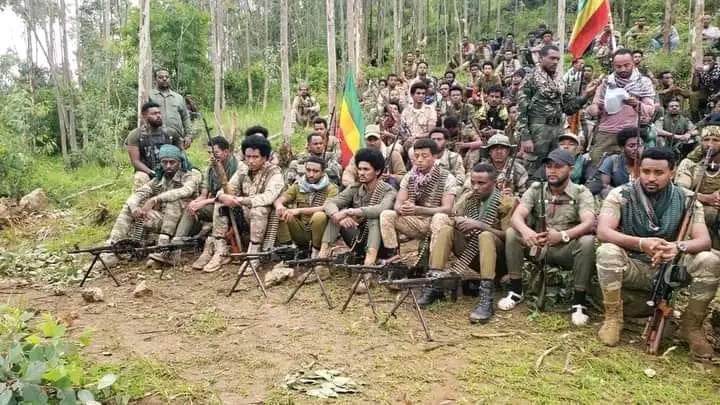
Ethiopia’s government on Aug. 4 declared a state of emergency in Amhara state over ongoing clashes between the federal army and local Amhara Fano militiamen. The Ethiopian army and the Fano militia were allies in the two-year war in the northern Tigray region. Their relationship later deteriorated, in part over recent efforts by federal authorities to disband regional paramilitary groups. (Jurist, Al Jazeera)
Photo via Facebook





Deadly air-strike in Ethiopia’s Amhara region
A presumed government air-strike on a busy town square in Ethiopia’s Amhara region has killed at least 26 people Aug. 13. The attack occurred in Finote Selam, a town in Amhara’s West Gojjam zone. The town is controlled by the Fano militia, but te big majority of those killed appear to have been civilians. (The Guardian)
Territorial question in Amhara struggle
Even during the war with Tigray, federal authorities and the Fano militia had eyed each other uneasily. Amhara’s regional forces were a key ally of the military against the Tigray People’s Liberation Front (TPLF), but the Fano had clashed regularly with federal forces in the months leading up to the war, with many Amhara fighters instinctively mistrusting Abiy, who is an Oromo, Ethiopia’s largest ethnic group.
Amhara forces took advantage of the war to seize Western Tigray, a fertile territory bordering Sudan long claimed by the Amhara, and an area called Raya. Human Rights Watch and Amnesty International say they waged a campaign of ethnic cleansing in Western Tigray—characterized by arbitrary arrests, killings, and deportations—that uprooted hundreds of thousands of Tigrayan residents.
In mid-2021, TPLF fighters recaptured most of their region and then pushed deep into Amhara, committing their own human rights abuses while also looting hospitals and schools. Amhara was mobilized for total war, with thousands of young men given rudimentary military training and sent to the front as militia. Many felt let down by the government and regular military, which had been unable to stop the TPLF advance.
Then, in April 2022, during a truce with the TPLF, Abiy moved against the Fano, launching a sweeping crackdown that saw thousands arrested.
After the signing of the Tigray peace deal, the sense of spiralling mistrust heightened. Even though Amhara’s vice president was part of the team that negotiated the peace, Amhara activists complained that their interests were not represented at the talks.
The final text of the peace deal says the future of “contested areas” will be settled according to the constitution. Since it was agreed, Abiy has touted the possibility of holding a referendum to determine the status of Western Tigray and Raya.
Even questioning the status of these territories is deeply unpopular with Amhara nationalists, who see their return to the TPLF as an uncrossable redline. (The New Humanitarian)
Local authorities and Amhara forces in Western Tigray Zone in northern Ethiopia have continued an ethnic cleansing campaign against Tigrayans since the November 2022, truce agreement. (Human Rights Watch)
Ethiopia rights commission: civilian killings in Amhara region
The Ethiopia Human Rights Commission issued a report condemning the killing of numerous civilians by drone strikes and house to house searches in the Amhara region of Ethiopia. The Oct. 30 report documented several incidents of extrajudicial killings, injuries, displacement and property destruction by the government security forces. (Jurist)
Demand investigation of civilian killings in Ethiopia’s Amhara region
The US government said it is “deeply concerned” by reports of targeted civilian killings in the town of Merawi town in the North Gojjam zone of the restive Amhara region. On Jan. 29, following six hours of intense fighting between the Fano militia and Ethiopian National Defense Force (ENDF) at least 50 civilian residents were allegedly killed by government forces in what residents described as mass “execution.”
Following the battle and evacuation of militia fighters from the town, government forces started conducting door-to-door searches, followed by the summary “executions,” residents told the Addis Standard. (Jurist, Addis Standard)
Ethiopia uses state of emergency to snuff dissent: Amnesty
Amnesty International issued a statement Feb. 19 urging Ethiopian authorities to stop using the country’s state of emergency to “silence peaceful dissent” by arbitrarily detaining politicians and journalists critical of the government.
The state of emergency, originally imposed for six months in August 2023 under Article 93 of the Ethiopian Constitution, granted the government authority to impose curfews, restrict movement, make arrests, conduct warrantless searches, ban the carrying of guns and other weapons, and restrict public gatherings.
On Feb. 2, Ethiopia’s parliament extended the state of emergency by four months. (Jurist)
Sudanese stranded by Ethiopia fighting
More than 700 Sudanese people are stranded on both sides of the Gallabat border crossing between Sudan and Ethiopia due to fighting in Ethiopia’s Amhara region between government forces and Fano militia. The UN said at least two refugees died in cross-border shelling as the fighting intensified. (TNH)